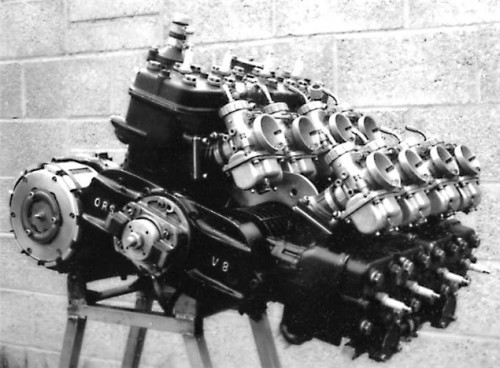Slippy exhaust pipes
Why they're so difficult to pull, and how to fix it...
There has recently been a thread on the Mailing List in regards to the amount of effort required to "pull" the typical slippy (adjustable) exhaust pipe that is common in many road racing classes.
Well... A bit over 20 years ago, I had the same frustration, and I'll explain what I found, and how I solved the problem.
The image below show's an approximation of a "typical" slippy exhaust pipe. I have not shown the outlet hole in the "can"... (and a number of other things are missing as well), but this will serve the purpose for now. The moveable rear (convergent) cone is shown in its "out" position by the blue lines... and in it's fully "in" position by the green lines. The thick magenta line is a rough representation of the cable which pulls the rear cone/stinger assembly.

OK... here's the problem in a nutshell: The amount of effort required to "pull" the rear cone is directly proportional to the difference in pressure between the front and back sides of the moveable cone. (There's some other minor things like friction, but they're insignificant compared to the pressure differential).
Since the the rear cone (at its big end) does not fit the large center section perfectly, some "pressure" leaks by the outside of the cone into the area behind the cone. If the outer rear cone (the one that supports the stinger) has too much clearance on the stinger (where I wrote "Here's the problem"), then the pressure behind the rear cone can "bleed" into the can (which has lower pressure than the inside of the exhaust pipe). This results in a pressure differential between the front (engine) side of the rear cone, and the back side.
THAT is what you are pulling "against" when you try to pull in your slippy pipe.
Now here's how I fixed the problem...
Years ago, Hartman Engineering made some very nice spun "outer" rear cones especially for slippy pipes. I started with one of those. They were made with a very large hole on the small end. (Oh... the other thing that was really nice about those Hartman cones is that they were very short. This allowed you to get the weld to the center section a long ways away from where the adjustable cone would be sliding.... which made it easier to keep the center section nice and round).
I made an insert for the small end of this cone (shown in red in the drawing below). This "insert" had a bit of a "bell-mouthed" shape to the inside diameter. I did this so that I could run a very tight fit to the stinger, without the stinger "binding" due to any misalignment that might exist. I also took the stinger material (before welding it to the cone) and had it hard-chromed, and then ground the outside diameter. This made it perfectly straight and round, as well as giving me a super fine finish that would resist any sort of galling or seizing. I gave the insert about .005 clearance on the stinger (as I recall).
How did it work?
Too well. At the time I was running Open class. Due to the power, Open engines were notorious for being almost impossible to pull the exhaust pipe for the full race (an hour long at the time). My first time on the track with this pipe was a complete surprise. The very first left-hand sweeper I went through, the rear cone went all the way in by itself, just from cornering force! The pipe was actually far too easy to pull. My solution was to experiment with "vent" holes into the can. With the clearance that I had given the stinger in my "support sleeve"... as well as the fit of the large end of the cone in the center section of the pipe... I ended up running a 3/16" diameter "bleed hole" from the outer rear cone (the short steep one in the drawing below) into the can. This gave just about the perfect "feel" in my case. I could operate the pipe handle with one finger... yet there was enough pressure on the cone to move it back out fairly quickly when I let go of the handle.

You may not care to build your own slippy pipe... and we're seeing less and less classes where slippys are allowed... but hopefully this might help some of you that still run them.
Just remember: the effort required to pull the rear cone is directly related to the pressure differential on the front and back sides of the moveable cone. Anything you can do to prevent leakage around the stinger and into the can will make the pipe easier to operate... up to the point (I discovered) where it's too easy.







 Reply With Quote
Reply With Quote

 .
. .
.






Bookmarks